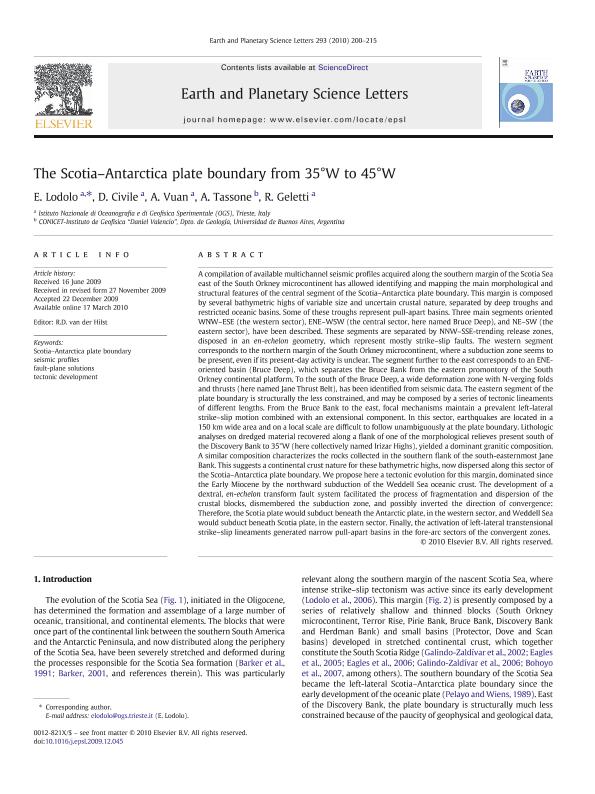Artículo
The Scotia-Antarctica plate boundary from 35°W to 45°W
Fecha de publicación:
04/2010
Editorial:
Elsevier Science
Revista:
Earth and Planetary Science Letters
ISSN:
0012-821X
Idioma:
Inglés
Tipo de recurso:
Artículo publicado
Clasificación temática:
Resumen
A compilation of available multichannel seismic profiles acquired along the southern margin of the Scotia Sea east of the South Orkney microcontinent has allowed identifying and mapping the main morphological and structural features of the central segment of the Scotia-Antarctica plate boundary. This margin is composed by several bathymetric highs of variable size and uncertain crustal nature, separated by deep troughs and restricted oceanic basins. Some of these troughs represent pull-apart basins. Three main segments oriented WNW-ESE (the western sector), ENE-WSW (the central sector, here named Bruce Deep), and NE-SW (the eastern sector), have been described. These segments are separated by NNW-SSE-trending release zones, disposed in an en-echelon geometry, which represent mostly strike-slip faults. The western segment corresponds to the northern margin of the South Orkney microcontinent, where a subduction zone seems to be present, even if its present-day activity is unclear. The segment further to the east corresponds to an ENE-oriented basin (Bruce Deep), which separates the Bruce Bank from the eastern promontory of the South Orkney continental platform. To the south of the Bruce Deep, a wide deformation zone with N-verging folds and thrusts (here named Jane Thrust Belt), has been identified from seismic data. The eastern segment of the plate boundary is structurally the less constrained, and may be composed by a series of tectonic lineaments of different lengths. From the Bruce Bank to the east, focal mechanisms maintain a prevalent left-lateral strike-slip motion combined with an extensional component. In this sector, earthquakes are located in a 150. km wide area and on a local scale are difficult to follow unambiguously at the plate boundary. Lithologic analyses on dredged material recovered along a flank of one of the morphological relieves present south of the Discovery Bank to 35°W (here collectively named Irizar Highs), yielded a dominant granitic composition. A similar composition characterizes the rocks collected in the southern flank of the south-easternmost Jane Bank. This suggests a continental crust nature for these bathymetric highs, now dispersed along this sector of the Scotia-Antarctica plate boundary. We propose here a tectonic evolution for this margin, dominated since the Early Miocene by the northward subduction of the Weddell Sea oceanic crust. The development of a dextral, en-echelon transform fault system facilitated the process of fragmentation and dispersion of the crustal blocks, dismembered the subduction zone, and possibly inverted the direction of convergence: Therefore, the Scotia plate would subduct beneath the Antarctic plate, in the western sector, and Weddell Sea would subduct beneath Scotia plate, in the eastern sector. Finally, the activation of left-lateral transtensional strike-slip lineaments generated narrow pull-apart basins in the fore-arc sectors of the convergent zones.
Archivos asociados
Licencia
Identificadores
Colecciones
Articulos(IGEBA)
Articulos de INSTITUTO DE GEOCIENCIAS BASICAS, APLICADAS Y AMBIENTALES DE BS. AS
Articulos de INSTITUTO DE GEOCIENCIAS BASICAS, APLICADAS Y AMBIENTALES DE BS. AS
Citación
Lodolo, Emanuele; Civile, D.; Vuan, A.; Tassone, Alejandro Alberto; Geletti, R.; The Scotia-Antarctica plate boundary from 35°W to 45°W; Elsevier Science; Earth and Planetary Science Letters; 293; 1-2; 4-2010; 200-215
Compartir
Altmétricas




